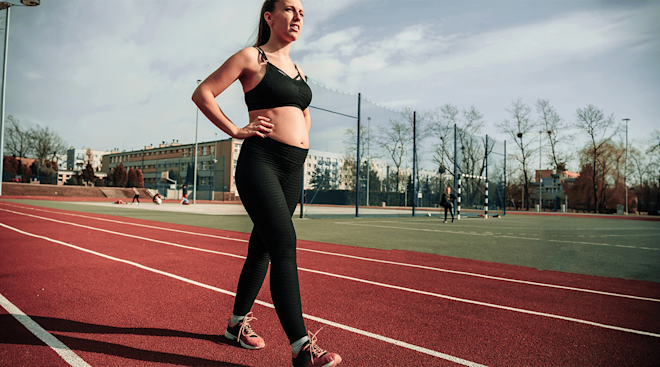4 Ways a Strong Lower Body Can Support Your Pregnancy
Wondering if you should skip leg day during pregnancy? As long as your doctor has given you the green light to exercise, keep up with those squats, deadlifts and bridges! Now that you’re walking for two, maintaining a strong lower body is actually more important than ever.
From start to finish, incorporating prenatal-friendly strength training will do wonders for your pregnancy—and there are four key reasons why powering up your legs, hips and glutes is especially beneficial. To give you the full scoop, we turned to a prenatal fitness expert from obé Fitness.
As the largest muscle groups in your body, your legs are the foundation for everything—and they’ll be working overtime to support you and baby throughout your pregnancy. Think of it this way: You’ll be continually carrying more weight than you’re used to, so training your base will only make it easier.
“The more you can strengthen the lower body as your body shifts and changes, the more you’ll be able to support everything above it,” explains Melody Zoller, CPT, obé’s training and programming manager who is PROnatal pre/postnatal certified.
Especially as your abdominal muscles get stretched over the course of each trimester, you’ll rely more and more on your legs to move around, knock out daily errands and get your fitness in. “They’re the powerhouse and support system behind your entire pregnancy,” says Zoller. If you keep them strong, the next nine+ months will feel more like a feel-good stroll than a grueling hike.
Another benefit of strong, healthy lower body muscles? They’ll dull and alleviate all the typical pregnancy pains—especially the pesky ones in the hips and lower back.
“As your belly grows, your pelvis naturally starts to tip forward, which really tightens the front of your body,” says Zoller. “It’s super important to strengthen the back of your body to counterbalance that tilt, otherwise you’ll naturally begin to feel more and more low back pain.”
The biggest weak spot? Your glutes—which tend to relax due to anatomical changes as your belly grows, putting extra strain on the hamstrings and surrounding muscles. Targeting them with exercises like bridges and deadlifts, which are safe throughout pregnancy, is the perfect remedy, according to Zoller.
“The stronger your glutes, the less likely you’ll be to feel pain,” she says. Plus, by stabilizing the pelvis, they prevent balance issues caused by your joints loosening (you can thank those relaxin and progesterone hormones for that side effect). As an extra perk, exercising your lower body can also improve circulation issues, reducing swelling, leg cramps and varicose veins.
As you progress in pregnancy, the extra weight of your growing belly tends to round your shoulders and perpetuate that problematic forward pelvic tilt. It’s only natural to hunch over or settle into your hips to compensate, and changes to your posture during this time are to be expected—but that doesn’t mean you can’t do something to offset them.
That’s where having a strong lower body can completely transform your experience. Specifically, maintaining strength in your posterior chain—the muscles down the back of your body—is key to restoring alignment and keeping you comfortable at every stage of pregnancy.
“It’s a balancing act between being super forward-dominant because your belly is growing and working the backside so that you can prevent as much postural discomfort as possible,” explains Zoller. As you strengthen everything below your waist to support your posture, you’ll find it easier to carry your baby.
Let’s be real: Laboring and delivering a baby is probably one of the hardest physical activities you’ll ever do in your life. “As you train throughout your pregnancy, you’re really training for this intense physical activity, so strengthening your lower body and making sure you’re in as good a shape as feels comfortable will help you get through that process,” Zoller says.
A set of powerhouse legs and glutes (hi, squats on repeat) will give you extra leverage when it’s time to push and—depending on the birthing position you choose—assist with muscular endurance and mobility.
And the benefits don’t end on Delivery Day. Lower body-focused strength training also prepares you for all the new functional movements of motherhood—like picking up a car seat from the ground or getting baby out of the crib (that’s what all those deadlifts are good for). In short, your legs will carry you forward every step of the way.
About the expert:
Melody Zoller, CPT, is a fitness instructor, mom and former musical theater actress based in New York City. She is the training and programming manager at obé Fitness, where she teaches power, HIIT, cardio boxing and bounce classes. She’s a personal trainer and group fitness instructor certified by NASM and ACE, and also holds a PRONatal Pre/Postnatal certification.
About obé Fitness:
obé Fitness is a premium fitness lifestyle destination that brings daily live classes, endless on-demand workouts and world-class instructors to your fingertips—anywhere, anytime, any screen. obé keeps members moving with 20+ class types and curated training programs, as well as only-at-obé moments such as celebrity guests and themed classes. Start your free trial at obefitness.com.
Please note: The Bump and the materials and information it contains are not intended to, and do not constitute, medical or other health advice or diagnosis and should not be used as such. You should always consult with a qualified physician or health professional about your specific circumstances.
Plus, more from The Bump:
Navigate forward to interact with the calendar and select a date. Press the question mark key to get the keyboard shortcuts for changing dates.



















































